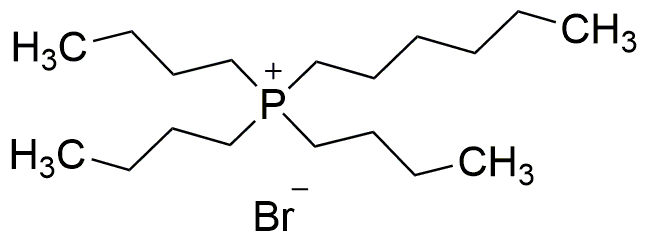Tributylhexylphosphonium bromide is widely utilized in research focused on:
- Green Chemistry: This compound serves as a phase transfer catalyst, enhancing the efficiency of chemical reactions while minimizing environmental impact.
- Biotechnology: It is used in the extraction and purification of biomolecules, aiding in the development of pharmaceuticals and bioproducts.
- Electrochemistry: The compound acts as an electrolyte in energy storage devices, improving the performance of batteries and supercapacitors.
- Material Science: It contributes to the synthesis of advanced materials, such as ionic liquids, which have applications in solvents and lubricants.
- Nanotechnology: This chemical is involved in the stabilization of nanoparticles, enhancing their functionality in various applications, including drug delivery systems.
General Information
Properties
Safety and Regulations
Applications
Tributylhexylphosphonium bromide is widely utilized in research focused on:
- Green Chemistry: This compound serves as a phase transfer catalyst, enhancing the efficiency of chemical reactions while minimizing environmental impact.
- Biotechnology: It is used in the extraction and purification of biomolecules, aiding in the development of pharmaceuticals and bioproducts.
- Electrochemistry: The compound acts as an electrolyte in energy storage devices, improving the performance of batteries and supercapacitors.
- Material Science: It contributes to the synthesis of advanced materials, such as ionic liquids, which have applications in solvents and lubricants.
- Nanotechnology: This chemical is involved in the stabilization of nanoparticles, enhancing their functionality in various applications, including drug delivery systems.
Documents
Safety Data Sheets (SDS)
The SDS provides comprehensive safety information on handling, storage, and disposal of the product.
Product Specification (PS)
The PS provides a comprehensive breakdown of the product’s properties, including chemical composition, physical state, purity, and storage requirements. It also details acceptable quality ranges and the product's intended applications.
Certificates of Analysis (COA)
Search for Certificates of Analysis (COA) by entering the products Lot Number. Lot and Batch Numbers can be found on a product’s label following the words ‘Lot’ or ‘Batch’.
*Catalog Number
*Lot Number
Certificates Of Origin (COO)
This COO confirms the country where the product was manufactured, and also details the materials and components used in it and whether it is derived from natural, synthetic, or other specific sources. This certificate may be required for customs, trade, and regulatory compliance.
*Catalog Number
*Lot Number
Safety Data Sheets (SDS)
The SDS provides comprehensive safety information on handling, storage, and disposal of the product.
DownloadProduct Specification (PS)
The PS provides a comprehensive breakdown of the product’s properties, including chemical composition, physical state, purity, and storage requirements. It also details acceptable quality ranges and the product's intended applications.
DownloadCertificates of Analysis (COA)
Search for Certificates of Analysis (COA) by entering the products Lot Number. Lot and Batch Numbers can be found on a product’s label following the words ‘Lot’ or ‘Batch’.
*Catalog Number
*Lot Number
Certificates Of Origin (COO)
This COO confirms the country where the product was manufactured, and also details the materials and components used in it and whether it is derived from natural, synthetic, or other specific sources. This certificate may be required for customs, trade, and regulatory compliance.

